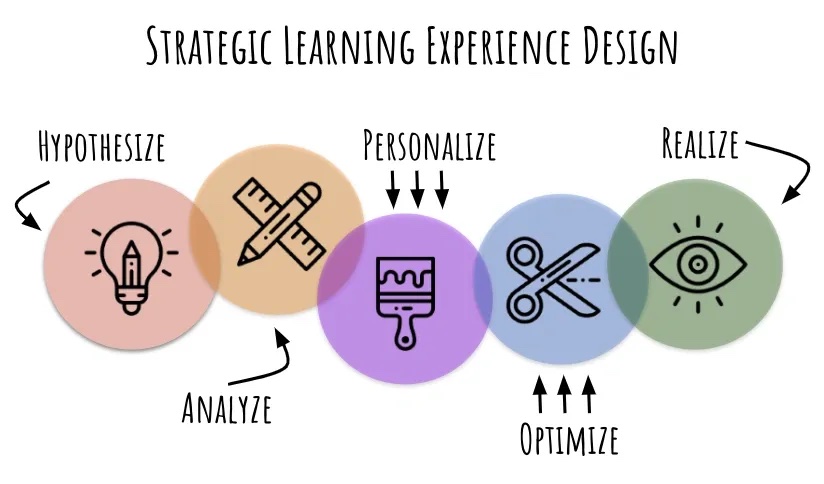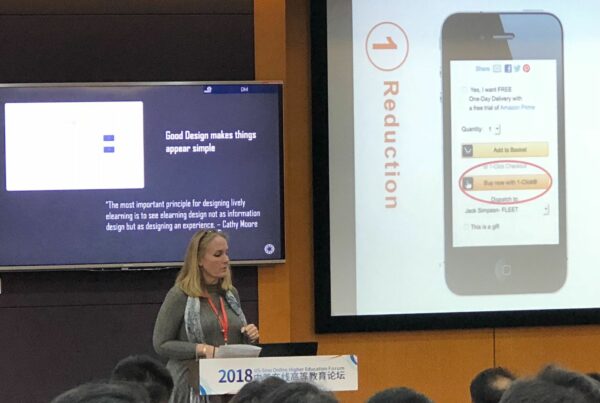Designing With Intent: A Strategic Learning Experience Design (SLED) Model powered by intelligent data.
There are many buzzwords in every industry and the learning technology space is no different. In today’s landscape, L&D practitioners are becoming increasingly more strategic inside their organizations and as a result, we find acronyms like ROI and SWOT analysis are no longer just topics we are asked to train about but are now tools or processes we need to incorporate into our own work.
Historically L&D has been able to leverage the Kirkpatrick Model that boiled down the evaluation of learning into 4 levels. Reaction, Learning, Behavior, and Results with very few folks ever really reaching the ability to measure level 4, the Results part. Each level provides a solid indicator of evaluating an intervention after the fact, but how successful would an organization be if other strategic players only focused on lagging indicators to evaluate success without ever first defining it?
Imagine if a CFO ran a company’s finances with only a budget based on their knowledge of budgets, and maybe some general demographic details about the business. Perhaps they track monthly data to see how the company feels about the budget and confirm funds are still coming into and flowing out of the business. However, they aren’t tracking activity monthly against a P&L to revise and update spending practices. Instead, they just get to the end of the fiscal year and report that “The team seems happy with the money we made and we can confirm 50,000 transactions were made this year.” This just simply doesn’t work. Knowing how many transactions occurred and that people felt good about it is nice information but it’s the rest of the details that really matter. How much was each transaction worth to the business, what deals were lost and why, and how much was spent to win new business, or maintain the company? The list goes on, and each financial indicator can help to refine and adjust practices and spending to support the larger strategic direction of the business.
Okay, so let’s ask the question, “Does learning experience design need to be strategic too?” And if so how do we go about achieving that? The fact is there has never been a more critical time for companies to ask this question. Forbes recently reported that 76% of the workforce self-identifies as being “unprepared”. Combine that with what McKinsey estimates as virtually all of today’s workforce – 94% – lacking the skills they will need to do their jobs in 2030. Let’s do the math – that’s just 7 years to retrain every person of working age. Addressing this challenge of true performance readiness could bring a genuine strategic competitive advantage to any organization. But to achieve this requires an ongoing commitment that is aligned to the rest of the organizational key performance indicators and not just to “Smile Sheets” or reporting course completions.
Measuring the performance readiness of an organization is more attainable than it may seem. Take for example the “learning curve” theory, with which organizations like NASA have measured time to performance readiness for years. This theory states that each time a person doubles their experience on the job, there is a constant rate of learning. Even minor increases in the pace of learning can yield substantial benefits. For example, a 1% increase in the rate of learning could save a large business £/$200,000 per year. By understanding who the learners are, what they know, and what they want to achieve, we can create extraordinary learning outcomes that have a measurable impact on the larger business goals. Even small optimizations can have big impacts. Would you celebrate reducing seat time by only two minutes in a compliance course? Maybe not, but what if you are a large organization of 50,000 employees – that two-minute reduction equates to 1667 hours of employee time saved by the business as a whole. What if we apply this same logic to customer enablement? How valuable might a 1% or 2% increase in customer retention or upsell be to your organization?
So to the question about “how do we go about making learning experiences within our organization strategic,” we did some research, and like any good business initiative we created a model.

The Strategic Learning Experience Design (SLED) Model addresses the need for a comprehensive approach to learning solution engineering and experience design. The five stages of the SLED model maximize the impact of any learning initiative. This can be applied at the macro level to an organization’s large strategic approach to all learning and development or at a more micro level to the planning of particular programs or initiatives.
- Hypothesize: The hypothesize stage sets the foundation by understanding the learning experience’s goals and aligning them with the broader organizational objectives.
- Analyze: This stage involves gathering and analyzing data on employee performance, behavior, and skill gaps, along with existing solutions and results, to establish a baseline for evaluation.
- Personalize: Tailoring the learning solution to individual needs and goals is central to the personalize stage. Leveraging data ensures each employee receives a personalized learning experience.
- Optimize: Continuously revisiting the data, this stage measures the effectiveness of different elements and replicates successful components to enhance the learning solution.
- Realize: The realization stage validates or invalidates the initial hypotheses by comparing the data from the new solution to the baseline data collected during the analysis stage.
Effectively using the data collected throughout the SLED model is essential. Avoid comparing unrelated data points and embrace the principles of deductive reasoning by seeking to falsify hypotheses. It’s crucial not to expect perfection; celebrating even partial success and sharing learnings contributes to continuous improvement.





